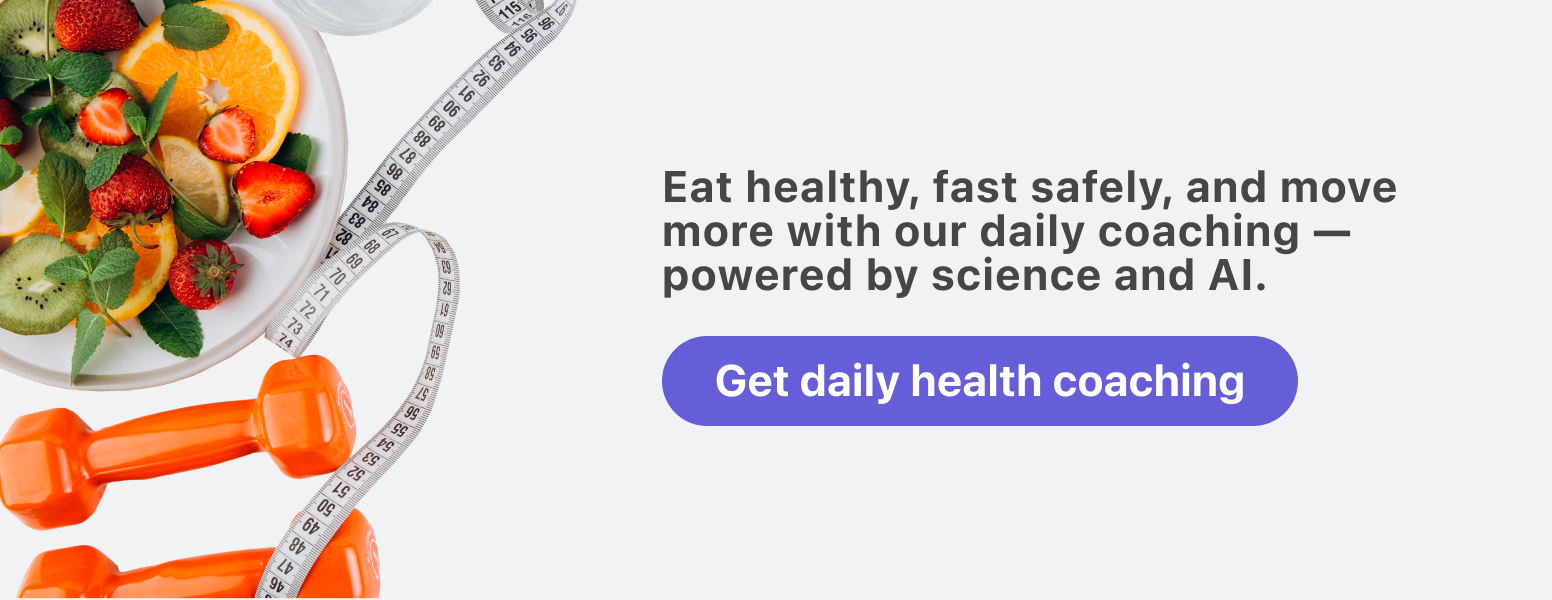Intermittent fasting for women over 50

So you’ve hit your 50s, and while it’s not the “over the hill” season you might have thought it’d be when you were a fresh-faced 22-year-old, it has arrived with its changes and challenges — both good and bad.

Some of the new experiences women 50+ can face include things like:
- hormonal changes
- joint pain
- brain fog
- weight gain
You and your friends still go on girls’ trips, but you now need to plan time for extra showers and skin care regimens (thanks for the night sweats and acne, hormones!). And you can still show that group of 20-year-olds how it’s done on the dance floor, but instead of recovering with all ten of you piled high in a single room and then hitting the beach bar the next morning, you’re hitting the ibuprofen and swapping your stilettos for comfy shoes.
The truth is that you now know that life doesn’t end at 50. In many ways, you’re just getting to the good stuff — you know yourself, you’re settled in your career and family life, and you don’t give two hoots what anyone else thinks of you.
But when it comes to your health, even with your best efforts, the season of “seasoning” brings changes that may threaten to slow down your plans. But you’re not out of options. Far from it! Intermittent fasting for women over 50 has been shown to help with all the not-so-graceful parts of getting older.
Let’s see if we can stop the slowdown.

Is intermittent fasting for women over 50 safe?
In general, intermittent fasting is safe for women over 50, but everyone is different. Although there have been some studies, more are needed with this specific group.
That said, research has shown that intermittent fasting can improve the risks and symptoms many women over 50 experience. More on that later.
Does intermittent fasting affect women’s hormones?
At 50 years old, most women are peri- or postmenopausal, meaning they are producing less estrogen and progesterone, the hormones that regulate your menstrual cycle. But these hormones are not only responsible for Aunt Flo — they have other jobs, too.[1] For instance, they show up in the hormonal processes that protect your heart,[2] support muscle retention,[3] keep your metabolism fired up,[4] and maintain mental sharpness.[5]
Although more research is needed, some studies have shown that intermittent fasting results in a promising reduction in androgens.[6] Androgens can cause problems like insulin resistance, excess hair growth, and skin issues, especially in conditions like PCOS. These hormones like to live in abundance in excess fatty tissues, so this benefit has mostly been seen in obese women.
On the other hand, intermittent fasting can make estrogen and progesterone begin to run low, which is already an issue for perimenopausal and postmenopausal women.
What is intermittent fasting?
Now that we’ve teased you with the idea that fasting can help with some of the effects of aging, let’s get into the details. What exactly is intermittent fasting?
Intermittent fasting is a way to reduce the amount of calories you eat by restricting the times you eat rather than what you eat. Instead of trying to survive on chicken breast, lettuce, and water (which we would never recommend), you can eat whatever you want — but only during certain times of the day.
Of course, to make a difference, you do have to pay some attention to what you eat. (We’ll get more into what to eat during intermittent fasting later.)
Why fast instead of cutting portions or certain foods? Well, most studies haven’t found a major difference in weight loss or health risks whether you count calories — as with traditional diets — or count the hours — as with intermittent fasting.
Plus, many people find it easier. With fasting, you only need to track two things:
- when you start eating
- when you stop eating
This gives you more flexibility to include foods that give you benefits besides nutritional ones, like comfort, connection to your culture, strengthening of social bonds, and so on.
How does intermittent fasting work?
You’re probably wondering, “If I can technically still eat what I want … how can intermittent fasting possibly work? Is this real life?”
Great question! Here’s how intermittent fasting works.
When you eat, your body uses those nutrients as energy. The hormone insulin increases and carries those nutrients where they need to go, storing any excess as fat.
It takes around 8 to 12 (or more) hours after you’ve eaten for your body to use up its stored sugar (glycogen) and begin to call on your fat stores for energy instead. Intentional daily fasting allows your body to regularly flip that metabolic switch and utilize this fat-burning mode.[7]
That said, intermittent fasting works best when combined with being active and making smart food choices. These three things together are what make the biggest difference.
What’s the best intermittent fasting schedule for women over 50?
It might surprise you just how easily intermittent fasting can fit into your life. There are several different intermittent fasting schedules you can try, and the ability to customize fasting to suit your needs is one of the things that makes it so appealing. You can choose the schedule that works best for you!
Here’s your intermittent fasting for beginners breakdown:
- Water fasting: Let’s get this one out of the way first. With water fasting, you consume only water (no tea, coffee, or other calorie-free drinks) for 24–72 hours. It’s not a sustainable way to lose weight, it’s not safe or healthy for your body, and we don’t recommend you try it unless you’re doing it on the recommendation of, and supervised by, your doctor.
- OMAD (one meal a day): On the OMAD schedule, you only eat one meal a day, essentially fasting for 23 hours each day. It’s a risky and difficult-to-sustain way of intermittent fasting, so to be safe, you’d need to have the blessing and support of your doctor. It’d take expertise and planning to make sure that one meal had all the nutrition you need, and as a 50-year-old woman, you’d run a higher risk of vitamin and mineral deficiencies.[8]
- Eat Stop Eat (ESE): The ESE fasting schedule fasting consists of 2 x 24-hour fasting periods during the week and eating as you normally would on the other 5 days. It looks like this:

Skipping full days of eating isn’t something we recommend for the same reason as OMAD — it’s hard to nail your nutritional needs when you’re eating zero calories twice a week.
- Alternate-day fasting (ADF): With ADF, you continuously alternate eating and fasting days throughout the week.

On fasting days, you can go zero calories or eat about 25% of your usual daily calorie intake. Because you’re fasting every other day, this schedule is tough and, again, runs the risk of causing nutrient deficiencies.
- The 5:2 schedule: 5:2 has the same weekly set-up as Eat Stop Eat, except that on your two fast days, you eat about 25% of your usual caloric intake (roughly 500–600 calories). This is a safer option than any of the above, yet we’d still suggest only taking this route with the support of your doctor.
- Time-restricted eating (TRE): These schedules come with various fast lengths. The most popular options are:
- 18:6. Intermittent fasting on the 18:6 schedule means fasting for 18 hours.
- 16:8. With 16:8 intermittent fasting, your fasts would be 16 hours long.
- 14:10. Intermittent fasting 14:10 style means 14-hour daily fasts.
- 12:12. On the 12:12 intermittent fasting schedule, it’s a (relatively) short 12-hour fast.
With each of these, you have the rest of the day once your fast is complete to get the nutrients you need. Ranging from a 6-hour eating window on 18:6 to a 12-hour eating window on 12:12, that’s plenty of time.
- The Warrior Diet (aka 20:4): 20:4 is a time-restricted intermittent fasting schedule, but with the eating window being only four hours long, we’d suggest you go for another TRE option.
So, with all that in mind, what’s the best type of intermittent fasting for women over 50?
As far as the research goes, the jury’s still out. More studies are needed on the effects of intermittent fasting on women, especially women over 50 and post-menopause.
Most studies done with this age group have used 16:8, and that’s proved effective for weight loss.
Over and above the research, though, what matters is your lifestyle, needs, and preferences. Which schedule would suit you best? Take our Simple quiz, and we’ll give you a schedule that matches your needs, and then make sure you have the information and tools to hit the ground running.
If that feels a step too far, no worries. Simply begin where you are and build up. What length of time do you currently fast for? If you don’t know, notice how long it is between your last meal or snack today and your first meal tomorrow. Then try stretching that time out by one hour. Just like that, you’re off!
The benefits of intermittent fasting for women over 50

Intermittent fasting has been shown to reduce both the risk and complications of many symptoms and diseases that can dull your 50-year-old shine (rude).
Like what, you ask? Well, let’s see.
As women get older, the production of sex hormones slows down.[4] These hormones play an important role in our overall metabolism, including insulin resistance, fat storage, cholesterol metabolism, inflammation control, hunger and satiety cues, and skin and sexual health. As they reduce, it can lead to:
- changes in skin and hair
- achy joints
- decreases in muscle mass and bone density (which makes falls and broken bones more likely)
- more difficulty in maintaining a stable weight (ever wondered why it’s harder to lose weight at 50 than 25? Of course you have — who hasn’t! This is partly why)
- less efficiency in distributing fat evenly (it tends to accumulate around your abdomen mostly)
- increased risk of heart disease, high blood pressure, and diabetes [9]
Intermittent fasting may help combat those changes because it can lead to benefits like:[10]
- weight loss / reduction in body fat
- better blood sugar control
- improved blood pressure
- reduced inflammation
All of these factors reduce your risk of heart disease, high blood pressure, and diabetes.
These benefits come most easily when intermittent fasting is paired with improvements in your eating and fitness habits, which in turn lead to additional health improvements, like strengthening your joints and bones, improving your balance, and putting the sparkle back into your skin and hair.
The potential risks of intermittent fasting for women over 50
Although we’ve talked about all the possible benefits of intermittent fasting for women over 50, it doesn’t come without risks.
Some of those risks include:
- low blood sugar, dizziness, and weakness
- nutrient deficiencies
- loss of muscle mass
- increased risk of osteoporosis
Many of these risks can be reduced with a balanced diet rich in whole foods and regular exercise. To be safe, speak with your doctor if you start fasting and notice any side effects or changes to your health that worry you.
10 tips for success for women over 50 doing intermittent fasting

If you’re keen to give intermittent fasting a go, here are some quick tips to help you succeed!
- Find the best intermittent fasting schedule for you.
If you’re not sure which schedule would work best, take our Simple quiz and let us do the thinking for you. Use the app to help you get into the swing of fasting each day and see how it feels. From there, you’ll learn where to adjust — do you need a longer eating window? Could a longer fast be possible? Do you need to drink more? And so on.
- Eat nutritious foods for maximum results.
You call the shots on what to eat during intermittent fasting. If you’re keen to optimize your results, focus on eating more of these types of foods:
- lean protein, like fish, tofu, and poultry
- whole grains, like oats, brown rice, quinoa, and whole wheat bread and pasta
- legumes, like lentils, peas, chickpeas, and beans
- fruits and veggies
- healthy fats, like avocados, eggs, nuts, olive oil, and seeds (these have anti-inflammatory properties, which are fantastic in helping you manage some menopausal-related symptoms too)
- calcium-rich foods, like yogurt, cheese, and fortified plant milks
- Try resistance training to preserve your lean muscle mass.
Adding resistance training into your routine is great for boosting the effectiveness of your fasting efforts and keeping hold of your muscle mass, which is super important as we age.[11]
It doesn’t have to be heavy, and training with resistance won’t turn you into a beefcake, we promise! We’re just talking about moving your body in a way that loads your muscles and makes them stronger — yoga and pilates fit the bill here, as could something like a kettlebell class at your local gym.
There are lots of options to try, none of which involve grunting next to the muscle-bound guy in the squat rack. (But if you’re into that, we love that for you!)
- Eat plenty of protein during your eating window.
It’s a good bet for both keeping your appetite under control and keeping your muscle mass.[12] Eating protein with every meal (yes, breakfast, lunch, and dinner!) will help you feel fuller, so hunger and cravings won’t derail your fast. And holding onto your muscle mass means your metabolism is more efficient, so you burn more calories for every activity you do!

- Listen to your body.
Whenever you’re trying something new, it’s a good idea to check in with your body and see what you notice. How’s your energy? How are you sleeping? How’s your digestion? Any headaches cropping up? And so on.
If something feels off, don’t hesitate to check in with your doctor or a registered dietitian.
- Drink plenty of water.
Staying hydrated while you’re intermittent fasting is crucial. It’s easier to get dehydrated when you’re eating less (as naturally tends to happen when you restrict your eating window) because about 20% of our fluid intake comes from food.
If you’re not a fan of water, check out our guide on what you can drink while fasting. We’ve got some ideas for adding extra flavor without the extra calories.
- Don’t be afraid to make mistakes.
Whenever you’re trying to do something new or change old, long-standing patterns, you’ll mess up sometimes. That’s a) completely normal and b) a good thing! We learn from making mistakes.
If you like to be prepared, you can read about some of the most common intermittent fasting mistakes; otherwise, don’t sweat it.
- Anticipate (but don’t worry about) the side effects.
Intermittent fasting does have a few side effects that crop up in the first couple of weeks. Nothing sinister; you’ll likely just be more hungry, fatigued, and snappish than usual for a while.
- Get clear on what breaks a fast.
Getting through your fasts isn’t just a matter of hanging in there — you also need to know what foods and drinks are fast-friendly and which aren’t. Check out our guide on what breaks a fast here.
- Learn how to adjust.
If you’re fasting, you most likely want results. If those results aren’t showing up, you need to know what to do. Here’s a full breakdown of what to try if you feel like intermittent fasting isn’t working for you.
The current research shows promise in intermittent fasting working for women in menopause.[6] It has been shown to combat the symptoms of some metabolic and hormonal changes and reduce the risk of chronic diseases that menopausal women commonly face.
A woman over 50 can certainly lose weight with intermittent fasting.[9] Intermittent fasting generally reduces overall calorie intake, increases fat burning, and may help preserve muscle mass.

- Horstman AM, Dillon EL, Urban RJ, Sheffield-Moore M. The role of androgens and estrogens on healthy aging and longevity. J Gerontol A Biol Sci Med Sci. 2012 Nov;67(11):1140–52.
- Giordano S, Hage FG, Xing D, Chen YF, Allon S, Chen C, et al. Estrogen and Cardiovascular Disease: Is Timing Everything? Am J Med Sci. 2015 Jul;350(1):27–35.
- Chidi-Ogbolu N, Baar K. Effect of Estrogen on Musculoskeletal Performance and Injury Risk. Front Physiol. 2018;9:1834.
- Mauvais-Jarvis F, Clegg DJ, Hevener AL. The role of estrogens in control of energy balance and glucose homeostasis. Endocr Rev. 2013 Jun;34(3):309–38.
- Berent-Spillson A, Briceno E, Pinsky A, Simmen A, Persad CC, Zubieta JK, et al. Distinct cognitive effects of estrogen and progesterone in menopausal women. Psychoneuroendocrinology. 2015 Sep;59:25–36.
- Cienfuegos S, Corapi S, Gabel K, Ezpeleta M, Kalam F, Lin S, et al. Effect of Intermittent Fasting on Reproductive Hormone Levels in Females and Males: A Review of Human Trials. Nutrients [Internet]. 2022 Jun 3;14(11).
- Anton SD, Moehl K, Donahoo WT, Marosi K, Lee SA, Mainous AG 3rd, et al. Flipping the Metabolic Switch: Understanding and Applying the Health Benefits of Fasting. Obesity . 2018 Feb;26(2):254–68.
- Conzade R, Koenig W, Heier M, Schneider A, Grill E, Peters A, et al. Prevalence and Predictors of Subclinical Micronutrient Deficiency in German Older Adults: Results from the Population-Based KORA-Age Study. Nutrients [Internet]. 2017 Nov 23;9(12).
- Christakis MK, Hasan H, De Souza LR, Shirreff L. The effect of menopause on metabolic syndrome: cross-sectional results from the Canadian Longitudinal Study on Aging. Menopause. 2020 Sep;27(9):999–1009.
- Vasim I, Majeed CN, DeBoer MD. Intermittent Fasting and Metabolic Health. Nutrients [Internet]. 2022 Jan 31;14(3).
- Khodadad Kashi S, Mirzazadeh ZS, Saatchian V. A Systematic Review and Meta-Analysis of Resistance Training on Quality of Life, Depression, Muscle Strength, and Functional Exercise Capacity in Older Adults Aged 60 Years or More. Biol Res Nurs. 2023 Jan;25(1):88–106.
- Hansen TT, Astrup A, Sjödin A. Are Dietary Proteins the Key to Successful Body Weight Management? A Systematic Review and Meta-Analysis of Studies Assessing Body Weight Outcomes after Interventions with Increased Dietary Protein. Nutrients [Internet]. 2021 Sep 14;13(9).
